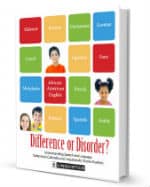As our demographics change, the need for bilingual SLPs is evident. What does it look like to be a bilingual SLP? Let’s listen in on an interview with a speech-language pathologist working with English Language Learners. As an English-only SLP, you may be surprised at how much you have in common with a bilingual SLP. And, more importantly, there are available resources for you to use to serve your diverse populations well!

1. To get started, would you mind giving me a brief description of your caseload? What type of setting do you work in and what percentage of your caseload speaks Spanish? Do you see clients primarily for articulation or language?
I currently work in an elementary school 3 days per week (26 student caseload) and see young children in the clinic 2 days per week. I have about 2 kids who I see only for articulation. The rest of my caseload is about half language only and half articulation and language.
2. When you see bilingual clients for articulation, what resource do you reference for developmental norms?
I use the following resources on our Bilinguistics website: Apples to Apples, Articulation Norms for Spanish and English, Phonological Process Norms -Spanish and English Comparison, and Early Sound Development Quick Reference Tables.
3. I imagine that there are certain characteristics of bilingualism that would affect the way a bilingual child would score on a language exam. How do you adjust the testing process accordingly?
Correct. When a child is exposed to two languages, this is investigated using a “difference vs. disorder” approach. Specifically, assessment data is obtained in both languages of exposure. Any noted errors or differences in communication skills are then analyzed and assigned to three main categories: 1) errors appropriate for the child’s age (developmental errors); 2) errors attributed to the interaction between the two languages spoken (cross-linguistic influence); and 3) atypical errors. Evaluation results take into consideration skills in both languages to indicate a child’s overall communication abilities. If a child is truly bilingual and able to participate in formal testing, we typically collect standardized scores in both languages, and note that the scores should be interpreted with caution as the student/client is not represented in the normative sample. We look at their basic language skills as a whole – ie. they may know color and shape vocabulary in English (exposure at school) while their vocabulary about food and home items are better known in Spanish (exposure at home). After doing the standardize tests, we can probe skills in the other language to make sure everything is covered. We also look at test items to see if there is a cultural or linguistic bias (i.e. idioms, typical breakfast food, etc). It is also very important to get a language sample in both languages. We will also take into consideration the typical language errors of Spanish-influenced English (see Common-Semantic-and-Syntactic-
4. When a child is truly bilingual and is seeing a bilingual speech therapist, do you target both languages during evaluation and therapy? In what ways would it be useful to utilize the client’s native language, if any?
We always assess both languages during evaluation. Typically during therapy, we use the language in which the child is more proficient, which in my case is usually Spanish, so it is easier for them to process it. Once the child learns a concept in one language (ie. colors, quantity, etc.) it will transfer to the other language. However, it is also important to take into consideration their language influence at the time. If you are working with a student at school and they are in an English only classroom, you may want to reinforce the English vocabulary to help them in class. All of my students are currently in bilingual classrooms.
5. I know that there are certain speech sound misarticulations that are common for every language (for example w/l and w/r in English). In your experience, how does bilingualism affect a child’s articulation? Do bilingual kids commit the typical speech errors of both languages they speak?
Yes, if a child is having difficulty producing for example the /t/, they would have difficulty with it in both languages. There are typical Spanish-influenced articulation errors that should not be considered a disorder during assessment. Furthermore we do not work on Spanish-influenced errors in therapy. Typically for children who are bilingual, we choose articulation targets/goals that have the sound in both English and Spanish. It is also important to note the phonotactics of each language. For example, words do not end in /t/ in Spanish, so if a bilingual speaker says “ca” for “cat”, it may not be indicative of a disorder – see if they can say a word with /t/ in the initial or medial position of the word. Check out our SlideShare presentation for more information: Difference vs. Disorder: Speech Development in Culturally and Linguistically Diverse Populations. We have more presentations on SlideShare you are welcome to look through.
6. What therapy techniques do you use that are unique to bilingual clients?
There are not really any specific techniques that are unique to bilingual clients, but careful assessment and goal selection is important for this population.
7. Could you please point me in the direction of some resources that have helped you along your career path as a bilingual speech-language pathologist?
I am particularly interested in speech and language developmental norms and typical deviations for native speakers of Spanish, as well as general guidelines for a bilingual speech-language pathologist. Yes, check out our SlideShare presentations as well as our free resources online. You can also subscribe to our blog which has some great information that is provided on a weekly basis. Below are direct links to some of our favorite (and most useful) tools:
If you are bilingual, read more here: Bilingual Speech Therapists Can Be an Island





